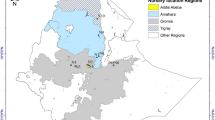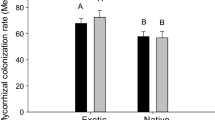Abstract
Five wetland prairie sites and six native plant species in western Oregon were examined to determine patterns of vesicular-arbuscular mycorrhizal fungal (VAMF) colonization. The sites differed in type and intensity of past land use. VAMF colonization was tested in situ on seedlings from both field-sown seeds and from transplants. Colonization was measured as the percentage of root length with arbuscles or vesicles. All species (Deschampsia cespitosa, Downingia elegans, Eriophyllum lanatum, Hordeum brachyantherum, Microseris laciniata, and Plagiobothrys figuratus) became colonized by VAMF during the study. This is the first report of mycorrhizal colonization of these important native species. All sites supported mycorrhizal colonization of some of the experimental species. Average VAMF colonization ranged from 58% to 92% but was unrelated to subjective rankings of land use intensity. These results suggest that VAMF inoculum at all sites was sufficient to support revegetation by at least some species of native plants.
Similar content being viewed by others
Author information
Authors and Affiliations
Additional information
Accepted: 16 September 1999
Rights and permissions
About this article
Cite this article
Ingham, E., Wilson, M. The mycorrhizal colonization of six wetland plant species at sites differing in land use history. Mycorrhiza 9, 233–235 (1999). https://doi.org/10.1007/s005720050272
Issue Date:
DOI: https://doi.org/10.1007/s005720050272




